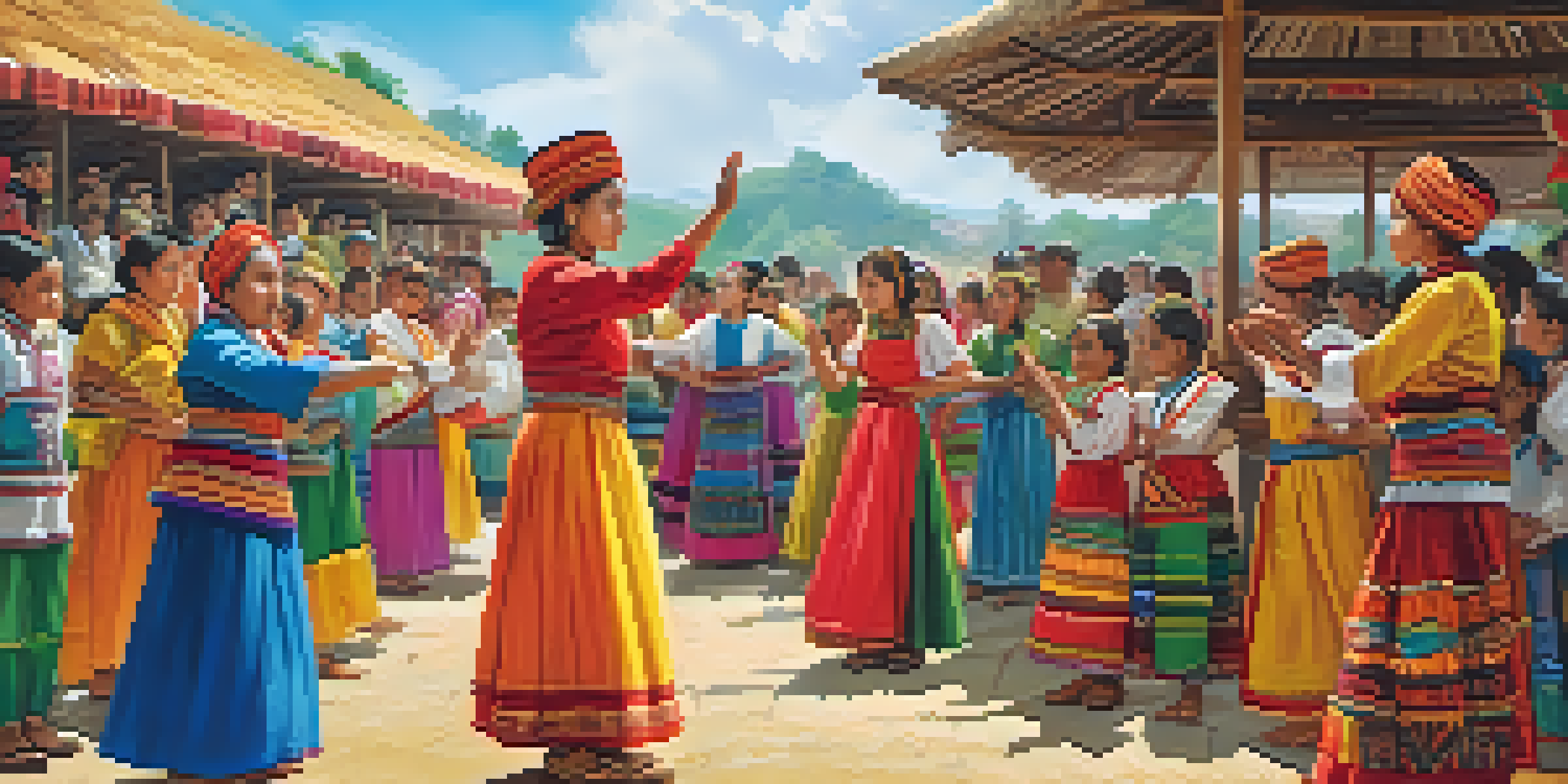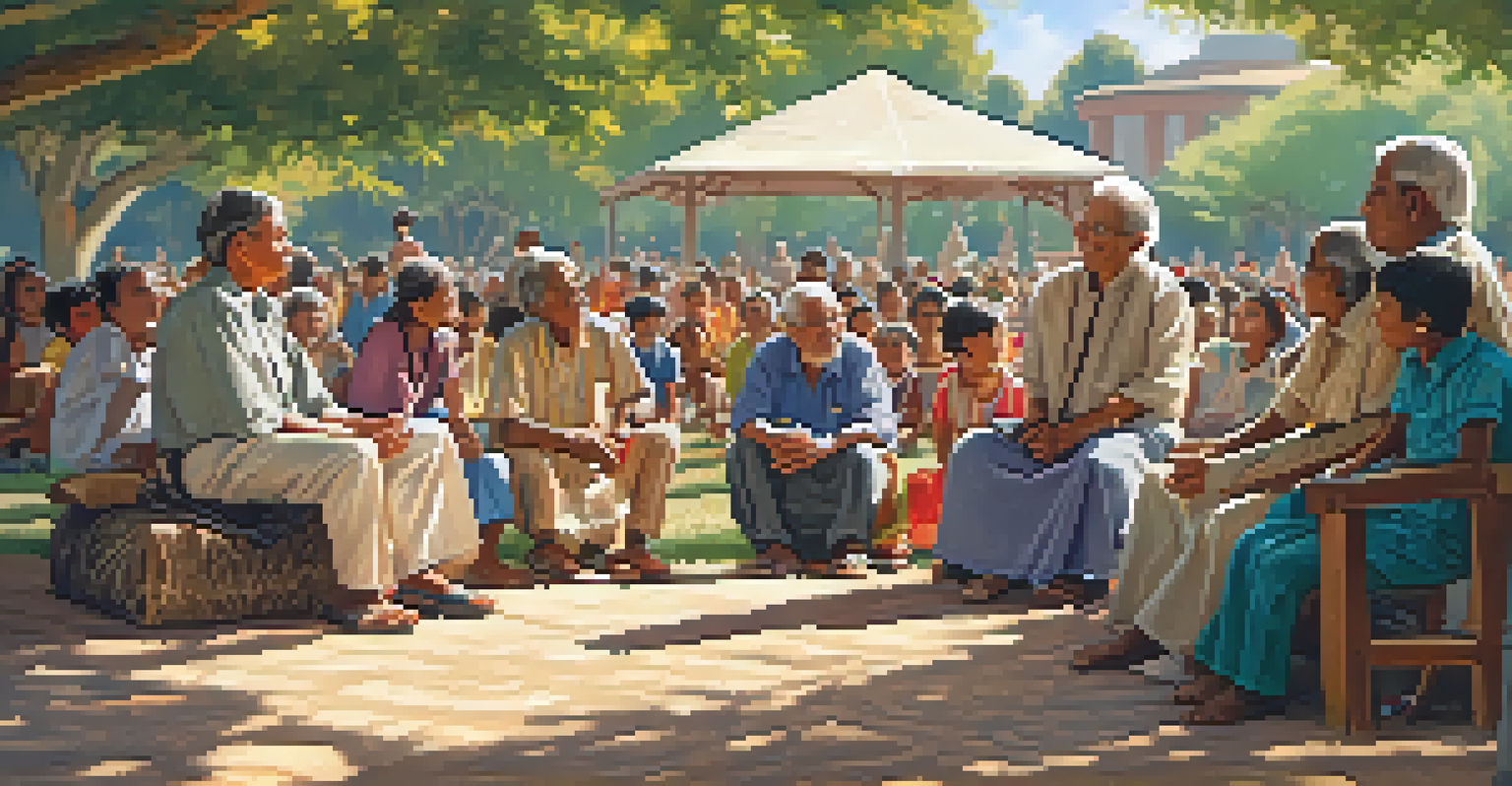Cultural Heritage Festivals: Educating the Next Generation

Understanding Cultural Heritage Festivals and Their Importance
Cultural heritage festivals are vibrant celebrations that showcase the unique traditions, arts, and values of various communities. These festivals often feature music, dance, food, and art, allowing participants to immerse themselves in different cultures. By bringing together diverse groups, they foster a sense of belonging and appreciation for history.
Cultural heritage is the foundation of our identity and the bridge that connects past, present, and future.
These events not only entertain but also educate attendees about the rich tapestry of human experience. They provide a platform for sharing stories, customs, and practices that might otherwise be overlooked or forgotten. As generations come together, the festival becomes a living classroom where history is experienced firsthand.
For the younger audience, these festivals can spark curiosity and encourage them to explore their own cultural backgrounds. By engaging with their heritage in a lively setting, children and teenagers are more likely to develop a sense of pride and understanding of their identity.
The Role of Festivals in Preserving Cultural Traditions
Cultural heritage festivals play a crucial role in preserving traditions that may be at risk of fading away. By showcasing these customs in a public forum, festivals help keep them alive for future generations. This preservation is vital for maintaining the cultural identity of communities, especially in an increasingly globalized world.

Through interactive activities, such as workshops and demonstrations, attendees can learn traditional crafts, cooking techniques, and dances. This hands-on approach makes learning more engaging and memorable, encouraging participants to carry these skills and knowledge into their daily lives. The tactile nature of these experiences helps solidify an understanding and appreciation for cultural practices.
Cultural Festivals Foster Community
These vibrant celebrations bring together diverse groups, promoting a sense of belonging and appreciation for shared history.
Moreover, festivals often involve storytelling sessions, where elders share tales that encapsulate the values and morals of their culture. These narratives not only entertain but also impart valuable lessons, ensuring that cultural wisdom continues to resonate with younger generations.
Encouraging Intergenerational Connections at Festivals
Cultural heritage festivals provide a unique space for intergenerational connections to flourish. Grandparents, parents, and children can share experiences and learn from one another, creating bonds that strengthen family ties. This shared experience fosters a sense of continuity and belonging that is essential for cultural transmission.
Festivals are like mirrors that reflect the culture of a community, allowing us to see who we are and where we come from.
When younger generations witness their elders participating in traditional practices, they are more likely to feel inspired to engage with their heritage. Whether it's watching a grandparent cook a traditional dish or participating in a folk dance, these connections can be deeply impactful. They help bridge the gap between past and present, making culture a living, breathing entity.
Such bonding moments are often accompanied by laughter, stories, and the joy of shared experiences. This emotional connection can instill a lifelong appreciation for cultural heritage, motivating young people to take an active role in preserving their traditions.
The Impact of Technology on Cultural Heritage Festivals
In today's digital age, technology plays a significant role in shaping cultural heritage festivals. From social media promotions to virtual reality experiences, technology can enhance the visibility and accessibility of these celebrations. This modern twist helps attract younger audiences who may be more engaged with digital platforms than traditional forms of communication.
Using technology, organizers can create interactive experiences that allow attendees to explore different cultures from the comfort of their homes. For example, virtual tours or live-streamed performances can reach a global audience, providing opportunities for education and engagement beyond the physical festival space. This approach can also highlight the importance of cultural diversity in an increasingly interconnected world.
Youth Engagement Preserves Heritage
Involving younger generations in festivals helps instill pride and responsibility for cultural traditions, ensuring their continuation.
However, it's essential to strike a balance between embracing technology and preserving the authentic experience of cultural heritage. While technology can enhance accessibility, the core values and traditions must remain intact to ensure that the festival's essence is not lost. This balance is crucial for educating future generations about their heritage.
Creating Educational Opportunities Within Festivals
Cultural heritage festivals often include educational programs designed to engage young minds. These programs may feature workshops, interactive exhibits, and hands-on activities that invite participants to learn about history, art, and cultural practices. By integrating education into the festival experience, organizers can foster a deeper understanding of cultural heritage among youth.
For instance, a festival might offer a cooking class where participants can learn to prepare traditional dishes. This not only teaches culinary skills but also imparts knowledge about the cultural significance of the food. By tasting and preparing these dishes, young people can form a personal connection to their heritage.
Additionally, many festivals collaborate with local schools to create field trip opportunities, allowing students to experience the event firsthand. These partnerships can enrich classroom learning and encourage students to explore their cultural identities outside of the school environment.
Involving Youth in Planning and Organizing Festivals
One of the most effective ways to engage the next generation is to involve them in the planning and organizing of cultural heritage festivals. By giving young people a voice in shaping the event, they develop a sense of ownership and responsibility. This involvement can lead to innovative ideas and fresh perspectives that breathe new life into traditional celebrations.
Youth committees can be established to brainstorm activities, design marketing materials, or even perform at the festival. By taking on these roles, young people can learn valuable skills such as teamwork, project management, and leadership. These experiences not only contribute to personal growth but also empower them to continue the legacy of cultural heritage.
Technology Enhances Festival Experience
Modern tools, like social media and virtual tours, increase accessibility and engagement, attracting younger audiences while preserving authenticity.
Moreover, their active participation can inspire peers who may not have previously engaged with their cultural roots. When young people see their friends taking part in organizing the festival, it can create a ripple effect, encouraging broader participation and interest in cultural traditions.
The Future of Cultural Heritage Festivals and Youth Engagement
Looking ahead, the future of cultural heritage festivals hinges on their ability to adapt and resonate with younger generations. As society evolves, these festivals must find creative ways to engage youth while remaining true to their cultural roots. This adaptability is crucial for ensuring that these celebrations continue to thrive in the years to come.
Innovative programming, such as collaborations with contemporary artists or incorporating modern technology, can help attract a diverse audience. By blending traditional practices with current trends, festivals can create a dynamic environment that appeals to both young and old. This fusion can lead to exciting new interpretations of cultural heritage.

Ultimately, the goal is to create festivals that inspire a sense of pride and belonging in youth. By investing in the next generation and fostering their connection to cultural heritage, we can ensure that these invaluable traditions are passed down and cherished for years to come.